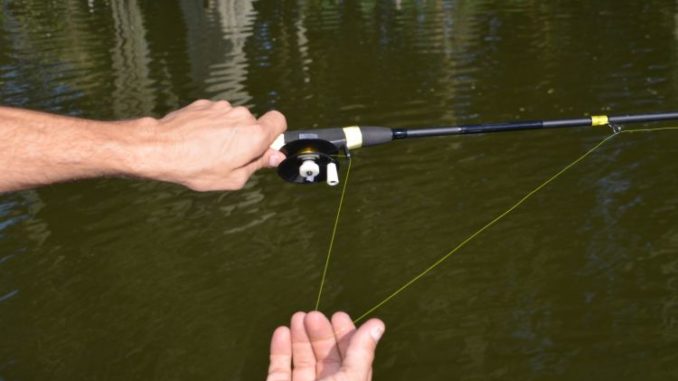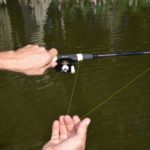
Watching Blaine Salter passionately teach people jigging technique at the Louisiana Sportsman’s Show is entertaining.
“The Salter Jiggin’ Pole is not just a rod,” the über-salesman said. “It’s an entire system of fishing that, once learned, separates itself by using three styles of fishing combined into one.
“Once you learn the system and it grows on you, there’s nothing that can replace what this jig pole can do. The free-spooling method allows you to reach all the areas of game fish habitat. It allows you to cast underneath overhanging trees and boat docks, go down and through tree tops, shallow or deep, with or without a cork.”
Each jig pole comes with a kit of tackle that maximizes the pole’s effectiveness, both for bream or sac-a-lait.
Salter was quick to point out the importance of the kit’s weed guards and the sliding corks.
“The weed guard is the single most-important piece of equipment,” he said. “It allows fishing in submerged tree tops. The sliding cork allows you to fish under trees and docks, as long as fishing at a fixed depth is productive, especially for bream.”
He added that use of a sliding cork allows for easy un-hooking from a snag. While retrieving all the slack line with the free hand, the rod tip is pushed down toward the hang; the cork slides down to the hook, allowing the rod tip to be used to push the hook free.
The weighted panfish jigheads in the kit are another point of pride for Salter. Specially designed for fishing with crickets, they come in three weights: 1/16, 1/32 and 1/64 ounce, all on No. 6 hooks.
The heaviest jig (1/16 ounce) is effective for tight-lining over 4 feet deep. The other two are usually used under corks.
The medium-sized jighead is for water 2 to 4 feet deep, and the smallest one is best for water less than 2 feet deep.
The most important thing to learn about the Salter Technique is the use of the non-rod holding hand to control the line. This is especially important for tight-line fishing for sac-a-lait without a cork.
Here are the steps to master this technique:
1) Loosen the nut on the reel and strip line out the length of the rod, plus 1 foot. Grasp the rod with the thumb stuck in the reel to control it and with the rod butt braced under the forearm. Position the rod so the guides are on one side rather than on top to keep the line from lying on the pole and restricting line movement.
2) Grasp the line between the reel and the first guide with open, curled fingers of the free hand and pull the line almost an arm’s length out to allow the jig to swing from the rod’s tip. With the upper arm positioned vertically and without moving it (important), raise the forearm to swing the lure back toward the body and then, pendulum-like, out toward the target.
3) Without releasing the line, move the line-holding hand closer to the rod to drop the bait in the spot.
4) While fishing, always hold the line in the free hand. Set the hook by both raising the rod tip and stripping in line with the free hand. Simply raising the rod tip without any stripping action might not provide enough force to punch the hook point through the weed guard and into the jaw of the fish.




